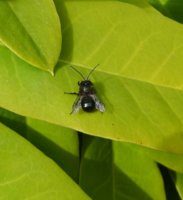Several people were curious when I casually mentioned that I raised Orchard Mason Bees. So, I am starting a thread where we can share our experiences and tips with each other. Surely, I cannot be the only one who raises them.
These small, gentle black bees are hardcore workers in the garden. Although they have a short lifespan, they are big urban pollinators of tree and cane fruit.
I started raising them way back in the early 90s. My first experience was ordering from Knox Cellars, north of Seattle, WA. At the time I lived in Pennsylvania.
Before I relate my experiences with them, I'd like to paste some information about them, from the Washington State University Agricultural Extension:
The orchard mason bee (Osmia lignaria) is a gentle beneficial insect that has potential as a pollinator of apples, cherries, and other fruits. It is found throughout most of North America, particularly in wooded areas but often around homes in towns and cities.
Homeowners sometimes become concerned when they see the bee entering cavities under shake siding or investigating nail holes or other cavities in wood during March through early June. These are not destructive insects, since they do not excavate holes in the wood, though they will clean out loose debris.
The orchard mason bee is slightly smaller than a honey bee and a shiny dark blue in color. The actual size of the bee depends largely upon the size of the hole in which it grew. Males are smaller than females, have longer antennae and an additional tuft of light colored hairs on the face. Females have hairs on the underside of the abdomen, called the "scopa", adapted for carrying pollen.
These small, gentle black bees are hardcore workers in the garden. Although they have a short lifespan, they are big urban pollinators of tree and cane fruit.
I started raising them way back in the early 90s. My first experience was ordering from Knox Cellars, north of Seattle, WA. At the time I lived in Pennsylvania.
Before I relate my experiences with them, I'd like to paste some information about them, from the Washington State University Agricultural Extension:
The orchard mason bee (Osmia lignaria) is a gentle beneficial insect that has potential as a pollinator of apples, cherries, and other fruits. It is found throughout most of North America, particularly in wooded areas but often around homes in towns and cities.
Homeowners sometimes become concerned when they see the bee entering cavities under shake siding or investigating nail holes or other cavities in wood during March through early June. These are not destructive insects, since they do not excavate holes in the wood, though they will clean out loose debris.
The orchard mason bee is slightly smaller than a honey bee and a shiny dark blue in color. The actual size of the bee depends largely upon the size of the hole in which it grew. Males are smaller than females, have longer antennae and an additional tuft of light colored hairs on the face. Females have hairs on the underside of the abdomen, called the "scopa", adapted for carrying pollen.



 Thanks so much for posting this, Jburgh!
Thanks so much for posting this, Jburgh!